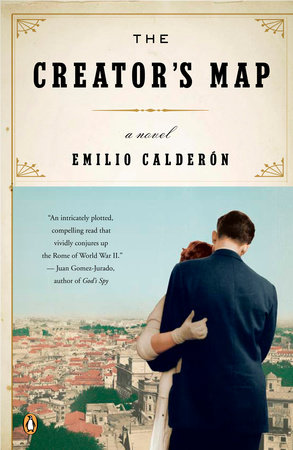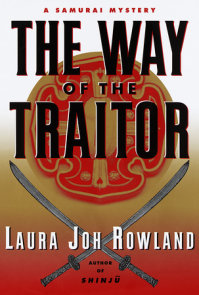READERS GUIDE
Questions and Topics for Discussion
INTRODUCTION
Set in Rome during the tumultuous years of the Spanish Civil War and World War II, The Creator’s Map is at once a compelling historical novel, a spy thriller, and a poignant love story.
As the novel begins, it is the year is 1952 and José María and his wife Montse are living a quiet life in the aftermath of World War II. When José María comes across a newspaper story about the death by decapitation of a man he encountered during the war a decade ago, Prince Junio Valerio Cima Vivarini, a train of vivid, visceral memories plunge him back into the most confusing, dangerous, and treacherous period in his life.
In 1937, the young José María, an architect and Spanish expatriate, is largely indifferent to the war raging in his homeland. While most of his fellow inhabitants at the Spanish Academy are fervent supporters of Franco and his Nationalist forces, José María busies himself with the pursuit of a beautiful librarian named Montse. But when José María and Montse sell a Renaissance text from the academy’s library, they are suddenly pulled into a fantastic Nazi plot to obtain mystical artifacts. One of these artifacts is the Creator’s Map, said to have been drawn by God himself, that will further the Nazi’s goal of world domination.
At the center of the novel stands the mysterious figure of Junio, a man who José María describes a collection of contradictions: “The cruelest but also the kindest of men, the most intolerant and at the same time the most understanding, the haughtiest and the humblest, the strongest and the most vulnerable” (p. 24). Junio seems to be working for the Nazis. Or is he a spy? And for whom? He befriends and protects José María and Montse and yet appears to be a cold-blooded murderer as well. Where do his sympathies really lie? And what is the truth of Montse’s relationship with him?
Like all great novels about espionage, The Creator’s Map dramatizes the treacherous—and potentially fatal—disjunctions between appearance and reality. Nothing is quite what it seems, and José María struggles to do the right thing in a haze of uncertainty about who he can trust, who is telling the truth, and who may be out to harm him. The novel also does much to evoke the oppressive atmosphere of Rome under Mussolini’s Fascism and the even more brutal Nazi occupation. Emilio Calderón shows how human relations are strained to the breaking point by fear, deception, and the threat of violence. Above all he shows how one ordinary man without political passions can be swept up by historical forces and drawn into a series of plots so complex he may never understand what has happened to him or why.
ABOUT EMILIO CALDERON
Emilio Calderón is a historian, editor, and author. He is the founder of Editorial Cirene, a publishing house in Spain. In 1995 he began writing young adult fiction. In 2003, Calderón received the Valle-Inclán Fellowship of the Spanish Royal Academy in Rome. The result was his first novel for adults, The Creator’s Map, the translation rights to which have been sold in more than twenty countries.
A CONVERSATION WITH EMILIO CALDERON
Q. What drew you to this particular aspect of World War II espionage?
When I began to think of the novel it was clear to me that I wanted the action to take place in Rome during World War II. For nine months Rome was occupied by the Nazis, which led me to investigate relations at the time between the Vatican and the Third Reich. That was when I discovered that the racial theories of the Nazis were founded upon certain esoteric beliefs.
Q. Could you talk more about the ancient stone tablet found in Dasha that became the source for your “creator’s map?
The Dasha Stone is an ancient tablet discovered in Russia that supposedly depicts a map of the Urals. It is thought to be so ancient that its creator had to be God, since it predated the appearance of man on earth. I transformed this notion in the novel a map of creation. In the same way that God handed Moses the Ten Commandments sculpted in stone, I suggest in my novel the possibility of a map of creation also fashioned by God.
Q. Is there historical evidence to show that the Nazis really were searching for supernatural treasures such as the ones you describe in your novel?
The historical evidence regarding the search for objects of esoteric power by the Nazis is indisputable. Heinrich Himmler, the head of the SS, created an esoteric sanctuary in Wewelsburg, Saxony, whose members were the leaders of the SS, who were in turn members of an esoteric order called the Thule. Thule was a sort of Atlantis of the north, where man-gods from whom the Aryan race was descended supposedly dwelled. Himmler sent an expedition to Tibet to seek out these superior beings in the Himalayas, and he himself traveled to the monastery of Montserrat, in Barcelona, to search for the Holy Grail. His adviser on esoteric themes was an enigmatic fellow named Otto Rahn who, curiously enough, also served as the Third Reich’s ambassador to Rome during the occupation of the Italian capital.
Q. This is your first novel for an adult audience, though you’ve been writing young adult fiction since 1995. What challenges did you face in making the transition to writing for more sophisticated readers?
Perhaps the most complicated challenge has been developing a suitably richer language and a subtler metaphorical style. The structure is also different since, with young adult fiction, one tends to move the story in a relatively linear fashion. With The Creator’s Map, on the other hand, memory plays a pivotal role in weaving the narrative.
Q. How did you plot out the novel? Did you begin with a clear sense, a map, of how the story would unfold or did the plot take shape after you started writing?
I have to confess that I discovered my story at the Spanish Academy of Fine Arts in Rome. From the moment I arrived there on a literary fellowship, I became fascinated with the history of the institution itself. I soon learned that during the Spanish Civil War the academy had become the refuge of some fifty or so Catalan exiles, and that in order to survive they had to sell off the library’s collection, which was very old and contained manuscripts from the sixteenth century when the academy had served as a Franciscan convent. At that point I began thinking of incorporating into my plot the story of a young Catalan librarian and her relationship to a mysterious book that contains references to a map created by God.
Q. How helpful was your fellowship at the Spanish Academy in Rome? Did you begin writing the novel there?
José María Hurtado de Mendoza, the narrator and principal protagonist of my novel, is a real person. He was also at the academy on a fellowship—but for architecture—and his theme of study was fascist architecture. All my understanding of the architecture of the period which informs the novel I owe to my conversations with him. As for the second question, yes, I began writing the novel working in studio 18 at the academy in Rome, although I finished it in Madrid. The last part of the novel was written entirely at the National Library in Madrid.
Q. The Catholic church, particularly the Vatican, vacillated in its opposition to Hitler, at times fiercely opposing the Nazis and at other times collaborating with them. As a historian, what is your judgment of how the Catholic church behaved during the war?
It’s a delicate subject. The situation of the Catholic church was complicated. Pius XII understood perfectly well the realities of Nazi Germany, since he had served as Nuncio in that country for many years. He spoke fluent German. Although an encyclical was issued countering the politics of Hitler, the pope had never been definitive in his public condemnations. They say that this was because he did not want to put Catholic priests in danger, or for that matter, Catholic populations living in countries then occupied by Germany. It’s possible this was the case, but it’s also true that once Germany lost the war, some members of the Vatican Curia helped Nazi war criminals escape by furnishing them with false papers and providing them refuge until they managed to leave Italy.
Q. To what extent is The Creator’s Map historically accurate in its depiction of World War II espionage? Is the character of Junio based on a real person?
The Creator’s Map is a novel that approximates the realities of World War II espionage. In Rome alone, during the months of Nazi occupation, it is estimated that more than five thousand people were involved one way or another in spying. The character of Junio, while not based upon a real person as such, hopefully epitomizes the elements of the perfect spy or double agent from that period.
Q. Why do you think World War II, more than other wars, has inspired so many great novels?
Simply because World War II has been the most devastating of those ever endured by humanity. The nations affected, the bellicose factions which actually took part in the conflict, the innocent victims, the genocides of Jews, of Gypsies, and of homosexuals, the destruction of entire cities, the scale of the battles, the use of atomic bombs—in all of these aspects World War II reached apocalyptic proportions.
Q. Do you plan to write more adult fiction?
Definitely. Just last year in Spain I published a new novel for adults entitled The Jew from Shanghai, which was awarded one of the major literary prizes of my country. Though it takes place in China, the period is once again World War II.
DISCUSSION QUESTIONS
SPOILER ALERT




















